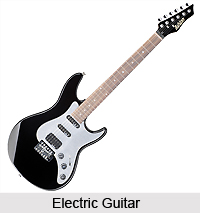 The electric guitar is an electrically amplified guitar. The initial reason for this amplification is that jazz required a stringed instrument that could be played solo and as rhythm accompaniment. It also needed to have a much louder volume than the standard stringed instrument, because it would have to be heard over the other noisy instruments of the jazz band. An electrode was thus placed under the strings and connected to a loudspeaker with a built-in amplifier. The result was the birth of a new instrument, infinitely louder than the classical guitar, and with an infinite number of new chords. It is through the guitar that electrical amplification first entered music.
The electric guitar is an electrically amplified guitar. The initial reason for this amplification is that jazz required a stringed instrument that could be played solo and as rhythm accompaniment. It also needed to have a much louder volume than the standard stringed instrument, because it would have to be heard over the other noisy instruments of the jazz band. An electrode was thus placed under the strings and connected to a loudspeaker with a built-in amplifier. The result was the birth of a new instrument, infinitely louder than the classical guitar, and with an infinite number of new chords. It is through the guitar that electrical amplification first entered music.
The construction of the electric guitar may vary in terms of the materials used, the shape of the body, and the configuration of the neck, bridge and pickups. However, there are certain basic features found in all electric guitars. The headstock contains the metal machine heads, which are used for tuning; the machine heads, which the player turns to change the string tension and thus adjust the tuning; the nut is a thin fret-like strip of metal or plastic which the strings pass over as they first go onto the fingerboard; the frets, which are thin metal strips which stop the string at the correct pitch when a string is pressed down against the fingerboard; the truss rod , a metal cylinder used for adjusting the tension on the neck (not found on all instruments); decorative inlay, a feature not found on lower-cost instruments. The body of this instrument is made of wood which is painted and lacquered, but some guitar bodies are also made of polycarbonate or other materials. Typical woods include alder (brighter, but well rounded), swamp ash (similar to alder, but with more pronounced highs and lows), mahogany (dark, bassy, warm), poplar (similar to alder) and basswood (very neutral).The pickups are usually magnetic but may also be piezoelectric transducer pickups. Apart from this, the electric guitar also contains control knob for volume and tone perimeters, a fixed bridge, and a plastic pickguard to protect the body of the guitar from scratches.
The earliest electric guitar, made by Rickenbecker in 1931, was a hollow-bodied acoustic instrument with tungsten steel pickups. During the 1950s, three elements were added, each with its own sound spectrum- control knobs, foot pedals, and other operating controls. These provided for an unprecedented sound spectrum and enhanced volume. By distorting the signal, the volume could be increase, a technique now standard in all types of popular music. The electric guitar uses pickups to convert its metal string vibration into electricity. This is amplified with an instrument amplifier. The output is altered with guitar effects such as reverb or distortion. These days the guitars are usually connected linked to an amplifier`s electronics without a cable, enabling the musicians to move all over the stage. The slide guitar is a feature of country and western music, which may also have foot-and knee-operated pedals. This guitar usually rests on a tripod and has one or two necks. It is a cross between the classical six-string guitar and a four string bass guitar, but like the Hawaiian guitar, the characteristic slide guitar sound is produced by sliding a metal bar over the strings.
The electric guitar was a key instrument in the development of musical styles that emerged since the late 1940s, such as Chicago blues, early rock and roll and rockabilly, and 1960s blues rock. It is used in almost every popular music genre. The best-known makes of electric guitar, Gibson and Fender are American. It was Les Paul , a virtuoso on the electric guitar who contributed substantially to new designs, who first demonstrated that the sound board no longer served a purpose, and the hollow instrument was replaced by a board made to resemble the model of a guitar, the "solid-body guitar." The first real solid body was made by Gibson in 1952, to Les Paul`s design. The solid body also exists as a bass guitar, which usually has four metal strings.
In Indian music, the electric guitar is often incorporated into the realm of Carnatic music. It was introduced in Carnatic music by S. Prasad in the seventies. Apart from the field of Indian classical music, the electric guitar continues to be a popular instrument in the stage of Indian music. It is used in film music compositions as well as for concerts in popular music, albums etc.




















